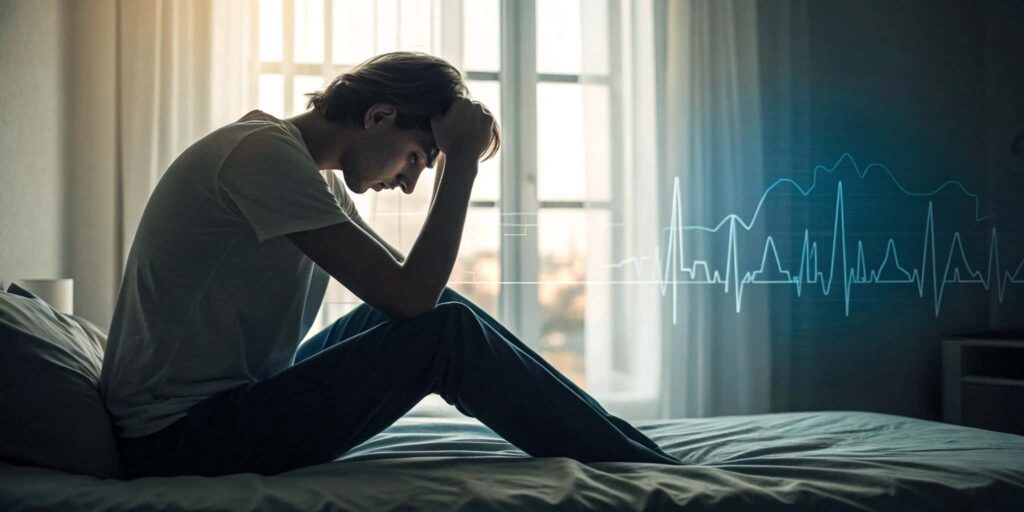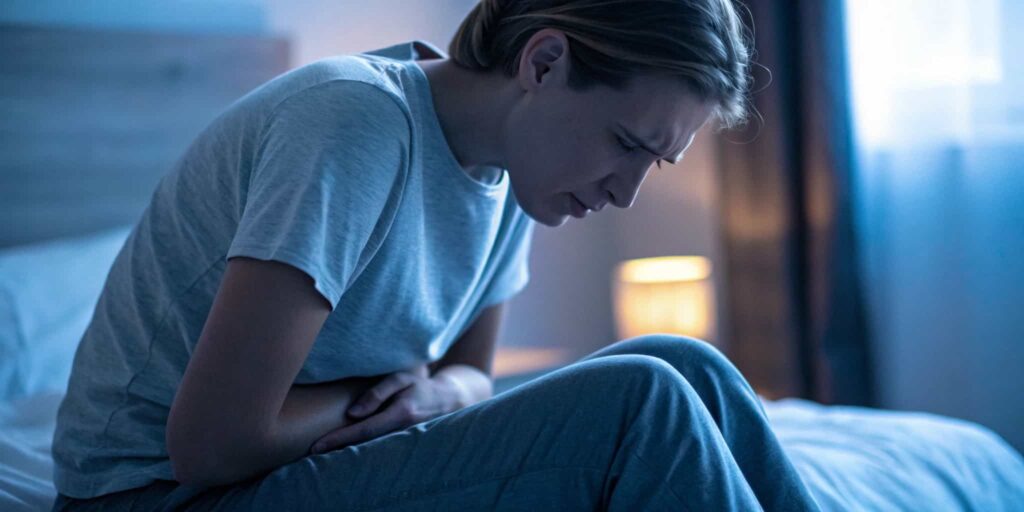Anxiety is something that affects a lot of people, and it can show up in ways you might not expect. We usually think of anxiety impacting our thoughts and emotions, but it can also cause physical symptoms that feel very real. One surprising thing many don’t realize is that anxiety can sometimes make you feel like you have symptoms of something serious, like an STD.
This is known as “STD-related anxiety” or “paranoia.” In this article, we’re going to explore how anxiety can trick your body into feeling like you’re dealing with an STD, what those symptoms can feel like, and how to manage it.
Anxiety And Its Physical Manifestations – Find Relief And Feel Better!
What is Anxiety?
Anxiety is a natural reaction to stress or situations that we perceive as threatening. It’s that feeling of worry, fear, or nervousness about what might happen in the future. While it’s totally normal to feel anxious from time to time, especially in stressful situations, when anxiety becomes a constant companion, it can start to affect both our mental and physical well-being.

How Anxiety Triggers Physical Symptoms?
When we feel anxious, our body goes into “fight or flight” mode, which is our natural response to perceived danger. This triggers a bunch of physical changes, like a racing heart, shallow breathing, and tense muscles. Our body also releases stress hormones like cortisol. While this is a helpful response in short bursts, if anxiety becomes chronic, it can lead to ongoing physical symptoms—including some that might feel similar to the signs of an STD.
So, How Does Anxiety Cause False STD Symptoms?
When you’re anxious about something, especially your health, your body goes into a heightened state of alertness. It’s like your body is preparing to face a threat, even if there’s no real danger. But when your anxiety is focused on something like the fear of contracting an STD, your stress response can cause physical symptoms that mimic the real thing.
For example, your muscles might tense up, or you could feel discomfort in places you normally wouldn’t notice. This can trick your mind into thinking something’s wrong, even when there’s nothing to worry about. It’s a cycle that feeds itself, making you feel more anxious and causing more symptoms that only heighten the fear.
What Is Somatic Symptom Disorder (SSD)?
Some people with anxiety develop a condition called Somatic Symptom Disorder (SSD). This means they start worrying so much about their physical symptoms (like genital discomfort or pain) that they become convinced something serious is wrong, even when there’s no actual medical issue.
People with SSD often find themselves visiting multiple doctors, looking for answers to the symptoms they’re feeling. However, the cause of their discomfort is really tied to anxiety, not an infection or illness. It’s a cycle where the worry about the symptoms causes more physical discomfort, which only fuels the anxiety.
Common Anxiety Symptoms That Can Feel Like STDs – Recognize the Signs & Find Peace of Mind!
When you’re feeling anxious, your body can react in ways that might make you think something serious is wrong, like having an STD. Here are some common symptoms that anxiety can cause:

Genital Discomfort Or Pain:
Anxiety can make your muscles tense up, especially in the pelvic area. This can lead to feelings of tightness or discomfort in the genital region, which might feel similar to what someone with an STD might experience. But the truth is, it’s not caused by an infection—it’s just your body reacting to stress.
Urinary Issues:
Stress and anxiety can make your pelvic muscles tighten, which can cause difficulty or pain while urinating. This might feel like a urinary tract infection (UTI) or even an STD, but it’s really just anxiety affecting your body in a way that makes things feel uncomfortable.
Perceived Changes In Genital Appearance:
When you’re anxious, you might start noticing things about your body that aren’t actually there. For example, you could think that your genitals look red or swollen, even though nothing has changed. Anxiety makes you hyper-aware of these sensations, which can lead to a lot of unnecessary worry.
Itching Or Irritation:
Itching or irritation in the genital area is another symptom that can be caused by anxiety. When you’re stressed, your body becomes more sensitive to sensations, making you feel like something is wrong when it’s really just your body reacting to stress.
How Do You Know If Your Symptoms Are Anxiety or an Actual STD?
If you’re experiencing symptoms like the ones we mentioned, how do you know if it’s anxiety or something more serious, like an STD? Here are a few signs to look for:
- No Exposure Risk: If you haven’t had sexual contact or haven’t been in a situation where you could have contracted an STD, then the chances of having one are very low. If your symptoms pop up out of nowhere, without any reason to believe you might be at risk, it could very well be anxiety causing the problem.
- Symptoms Come and Go: STD symptoms usually stay pretty consistent. They don’t typically come and go quickly. But if your symptoms seem to disappear for a while and then come back when you’re stressed or anxious, it’s more likely that anxiety is the cause.
- Other Anxiety Symptoms Are Present: If you’re dealing with other anxiety symptoms, like constant worry, restlessness, or trouble concentrating, that’s a big clue that your physical symptoms might be tied to anxiety. If anxiety is affecting your thoughts and emotions, it’s likely that it’s also showing up in your body.
- You’ve Got a Clean Bill of Health: If you’ve been tested for STDs and the results came back negative, it’s important to trust those results. Anxiety can make you second-guess yourself, but medical tests are usually very accurate. If you’ve had negative results and are still worried, that’s a strong sign that anxiety might be the culprit.
What Treatments Can Help With Anxiety-induced Physical Symptoms?
If you find yourself struggling with symptoms that are making you think you’ve contracted an STD, it’s important to know that you’re not alone, and there are ways to manage it. Here are some tips for managing anxiety and the physical symptoms that come with it:

Cognitive Behavioral Therapy (CBT):
CBT is a therapy that helps you identify negative thought patterns and replace them with healthier, more realistic ways of thinking. If you’re constantly worried about STDs, a therapist trained in CBT can help you challenge those thoughts and teach you how to manage anxiety more effectively.
Relaxation Techniques:
Stress-reducing activities like deep breathing, progressive muscle relaxation, and meditation can help calm your mind and reduce physical symptoms like pelvic tension. When you feel your body tighten up due to anxiety, try one of these techniques to help you relax.
Education And Awareness:
Sometimes, just knowing that anxiety can cause physical symptoms can help you feel more in control. Learning about how anxiety works in the body can help you understand why you might be experiencing discomfort and allow you to manage your worry more effectively.
Mindfulness And Stress Reduction:
Practicing mindfulness—whether through yoga, meditation, or just paying attention to your body in a calm and non-judgmental way—can help you reduce anxiety. By focusing on the present moment, you can avoid spiraling into worry and reduce the physical symptoms that come with stress.
Support Groups:
Sometimes talking to others who understand what you’re going through can be incredibly helpful. Support groups, either online or in person, can give you a place to share your experiences and learn from others who have faced similar challenges.
FAQs:
How long do anxiety-induced symptoms that mimic STD symptoms usually last?
These symptoms often fluctuate. They might come and go depending on your stress levels. When you’re calmer, they might subside, and when you’re stressed, they might flare up again.
Should I still get tested for STDs if I think my symptoms are due to anxiety?
It’s always a good idea to consult with a healthcare provider if you’re unsure. Testing can provide peace of mind. If your tests come back negative and your symptoms persist, it might be worth exploring anxiety as the cause.
Can therapy really help reduce the false STD symptoms caused by anxiety?
Yes, therapy—especially CBT—can be very effective. It helps you identify and challenge negative thoughts that fuel anxiety, ultimately reducing both your mental and physical symptoms.
Is it normal to keep worrying about having an STD even if all my tests are negative?
It can be normal if you’re struggling with anxiety. Sometimes anxiety makes you doubt even clear, negative test results. In such cases, working with a mental health professional can help you build trust in the results and manage your worries.
What can I do to stop obsessing over potential STD symptoms when I’m feeling anxious?
Focusing on stress reduction techniques like mindfulness, regular exercise, and structured therapy can help. Learning more about how anxiety affects your body can also empower you to recognize when it’s your mind playing tricks on you, so you can break the cycle of worry.
Conclusion:
Anxiety can indeed cause physical symptoms that feel like those of an STD, such as genital discomfort, urinary issues, or itching. These symptoms often occur due to muscle tension and heightened awareness caused by stress.
While anxiety doesn’t cause an actual infection, it can make you feel like something is wrong with your body. Understanding this connection is key to managing both your mental and physical health. If you’re unsure about your symptoms, talking to a healthcare provider can help you find the right solutions.
Also Read:








Leave a Reply